I love exploring art wherever I travel. Hawaii’s museums offer a special look at the islands’ unique blend of cultures and creative expression.

Whether you want to see ancient Hawaiian artifacts or modern masterpieces, you can visit several museums that showcase Hawaii’s rich history and vibrant artistry.
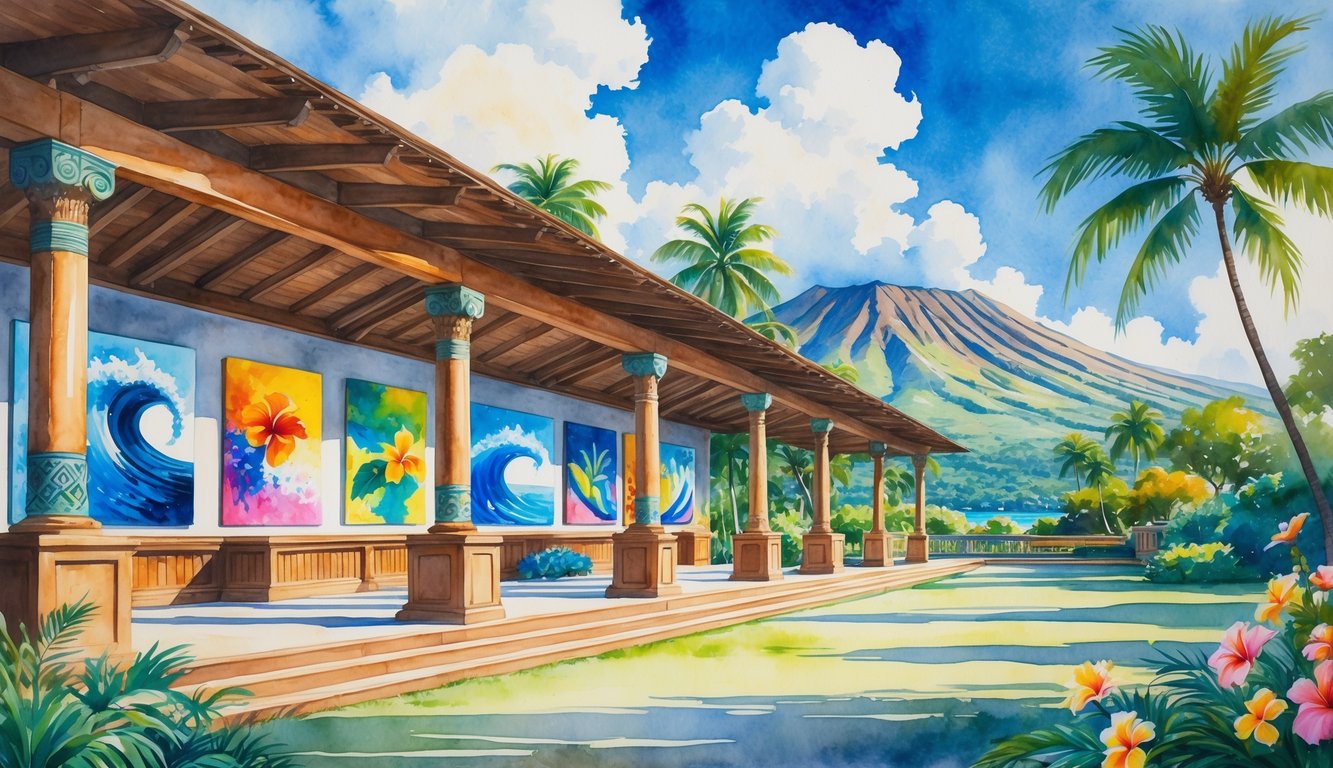
The best museums for Hawaiian art let you experience everything from traditional works to contemporary creations. You can learn about Hawaii’s past and present through these collections.
These museums hold pieces that reflect the islands’ spirit, natural beauty, and deep cultural roots.
From the Honolulu Museum of Art’s large collection to small galleries tucked away in unexpected places, you can find inspiring Hawaiian art across the islands.
If you love art or want to understand Hawaii better, these top spots are worth visiting.
Understanding Hawaiian Art and Its Importance
Hawaiian art is woven into the islands’ past. It tells stories about the roots, people, and traditions of Hawaii.
When I look closer, I see how the islands’ first settlers, daily life, and cultural values shape everything from ancient carvings to modern paintings.
Origins of Hawaiian Art
The first Polynesian settlers began Hawaiian art over a thousand years ago. They arrived by canoe, bringing skills like wood carving, barkcloth (kapa) making, and lauhala weaving.
These early art forms had real purpose in daily life, not just decoration.
People used many pieces for religious and social reasons. For example, chiefs and warriors wore feather cloaks and helmets during ceremonies.
The designs often included symbols important to their beliefs. These traditional skills and themes continue to influence today’s art, blending old and new.
Influence of Hawaiian Culture and History
Hawaiian art reflects major moments and changes in the islands’ history. Contact with explorers, missionaries, and immigrants brought new materials and ideas.
Hawaiian artists blended traditional motifs with influences from Asia, Europe, and the Americas. Over time, Hawaiian art evolved to include both local and foreign techniques.
Artists use painting, sculpture, and weaving to share stories about family, land, and history. Museums like the Hawaii State Art Museum showcase how art helps keep cultural identity alive.
Polynesian Settlers and Native Hawaiian Life
Polynesian voyagers were the first people to live in Hawaiʻi. Their way of life centered around the land and sea, and their art shows this connection.
You can find petroglyphs, or stone carvings, across the islands. These often show people, animals, or canoes.
Weaving, featherwork, and kapa making were common skills. Families passed these traditions down through generations.
Native Hawaiians used natural materials like shells, feathers, and plant fibers. Today, artists honor these traditions and combine them with modern ideas to keep Hawaiian culture alive.
Top Museums for Hawaiian Art in Oʻahu
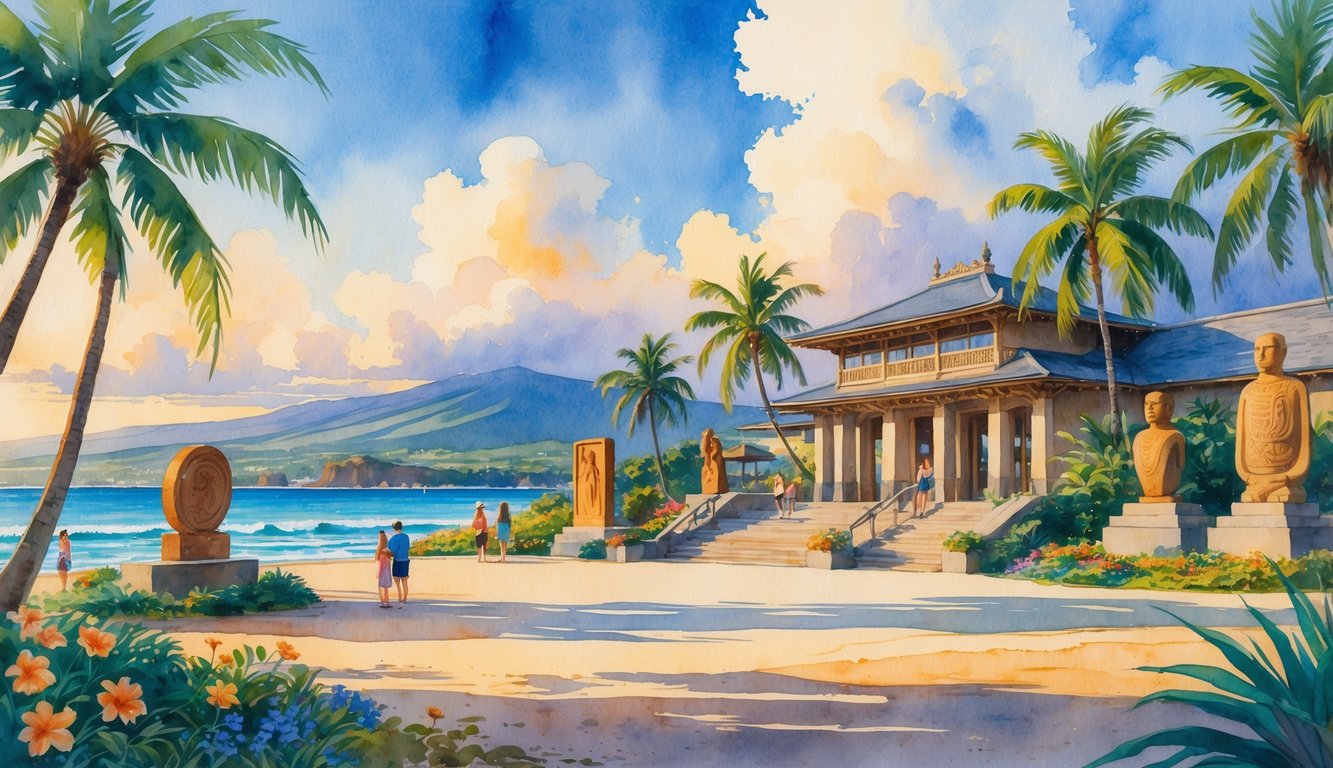
Oʻahu has great museums where you can explore Hawaiian artwork and culture up close. Each museum features diverse collections, from traditional artifacts to contemporary local art.
Honolulu Museum of Art
When I visit the Honolulu Museum of Art, I see one of the largest collections of Hawaiian art on the island. The museum houses over 50,000 pieces, including paintings, sculptures, and textiles.
I enjoy exhibits that showcase both historical and modern Hawaiian artists. The displays include works by Native Hawaiian creators, sharing stories and history through their art.
Some galleries focus on Pacific art, giving insight into connections between Hawaiian and other cultures.
Special exhibits highlight contemporary themes, royal portraits, and pieces inspired by the natural beauty of Hawaiʻi. The museum’s Doris Duke Theatre also screens art films and cultural programs.
The Honolulu Museum of Art offers guided tours and programs for visitors. The staff are friendly and happy to answer questions.
Bishop Museum
Bishop Museum, or the Bernice Pauahi Bishop Museum, helps you see genuine Hawaiian artifacts and understand their history. Princess Bernice Pauahi Bishop inspired the founding of this museum, which is Hawaii’s largest museum of natural and cultural history.
The Hawaiian Hall features traditional objects like feather cloaks, carved wooden bowls, stone tools, and historical photographs. These artifacts show Hawaiian craftsmanship and spiritual beliefs.
Exhibits explain the stories and lives of ancient Hawaiian chiefs and royalty. You can also find displays about the first settlers, the development of hula, and other important cultural practices.
The planetarium teaches how ancient Polynesians navigated the ocean using the stars.
Bishop Museum offers hands-on activities and demonstrations that connect you with local culture. For more details, visit Bishop Museum.
Hawaii State Art Museum
The Hawaii State Art Museum, or HiSAM, is a great spot for anyone interested in contemporary Hawaiian art. Located in downtown Honolulu, the gallery displays work by artists who live and work in Hawaiʻi.
HiSAM focuses on modern paintings, sculptures, photographs, and mixed media. The art reflects everyday life, landscapes, and stories of the islands.
Many pieces explore identity, environment, and Hawaiian rights. The museum’s exhibitions often feature local community artists alongside well-known names.
I’ve attended open art events here, meeting artists and trying creative activities. Admission is free, making it easy to visit more than once.
Events, workshops, and rotating exhibits make each visit unique. You can find more details at the Hawaii State Art Museum.
John Young Museum of Art
You will find the John Young Museum of Art at the University of Hawaiʻi at Mānoa. This smaller space focuses on Asian and Pacific Islander art, including a curated collection of Hawaiian pieces.
The museum displays works collected by artist John Young, with beautiful examples of historical and contemporary Hawaiian art. Exhibits often explore cultural identity and themes of migration and heritage.
Some displays highlight the blending of influences from different cultures in Hawaiʻi’s art scene. The museum updates exhibits regularly, so there is always something new.
Students and community members contribute to exhibitions, making the space feel lively and current. This museum is a good choice for a quieter setting and thoughtful collections.
Significant Museums on Hawaiʻi Island
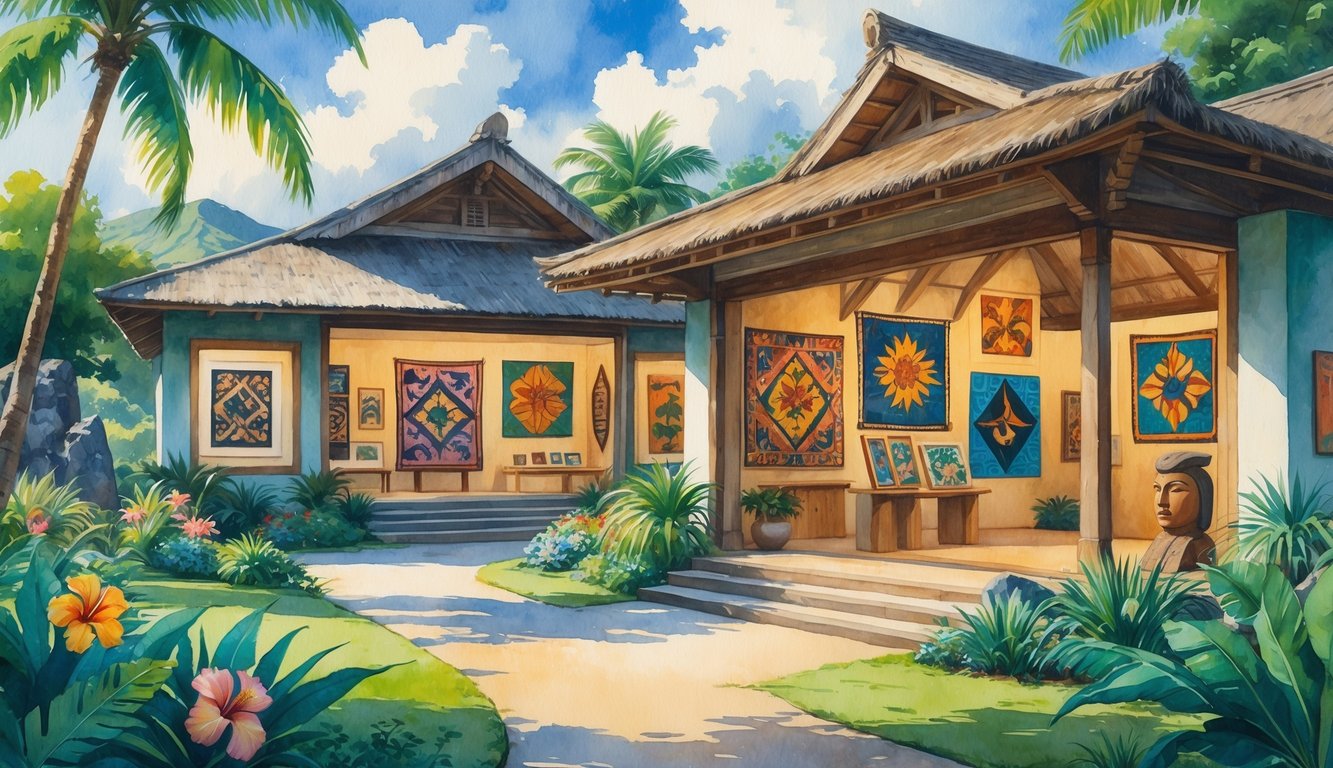
Hawaiʻi Island has museums with collections of cultural objects, natural history displays, and unique art pieces. These places let you explore how local stories, science, and art shape the island’s identity.
Lyman Museum and Mission House
The Lyman Museum and Mission House sits in downtown Hilo and is a great place to learn about Hawaiian and missionary history. The exhibits show real artifacts from early Hawaiian life, natural history collections, and rare minerals.
The restored Mission House, built in 1839, is the oldest wood-framed building on the island. When you visit, you can walk through old rooms and see how missionaries lived in the 19th century.
Displays of Hawaiian tools, clothing, and fossils give a window into the past. For more information, WorldAtlas lists the Lyman Museum as a must-visit.
‘Imiloa Astronomy Center
The ‘Imiloa Astronomy Center shows how Hawaiʻi combines modern science with ancient tradition. Located in Hilo, this museum focuses on astronomy, Hawaiian navigation, and the science behind volcanoes, stars, and planets.
‘Imiloa stands out for its hands-on exhibits. You can explore both space and Hawaiian culture at the same time.
The planetarium and interactive displays teach how Polynesians used the stars to travel great distances. The center connects the story of the universe with the story of Hawaiʻi, highlighting both science and culture.
Isaacs Art Center
The Isaacs Art Center sits near the center of Waimea and offers a peaceful spot to view Hawaiian and Pacific art. The gallery is in a historic 1915 building and displays oil paintings, woodwork, and old maps from local artists.
You can see rare koa wood pieces and furniture that show Hawaiian craftsmanship. Changing exhibitions let you experience both traditional and modern styles.
The gallery supports artists who tell the story of Hawaiʻi through their work. Visiting the Isaacs Art Center feels like a quiet retreat and a celebration of creative talent.
Celebrated Art Spaces in Maui
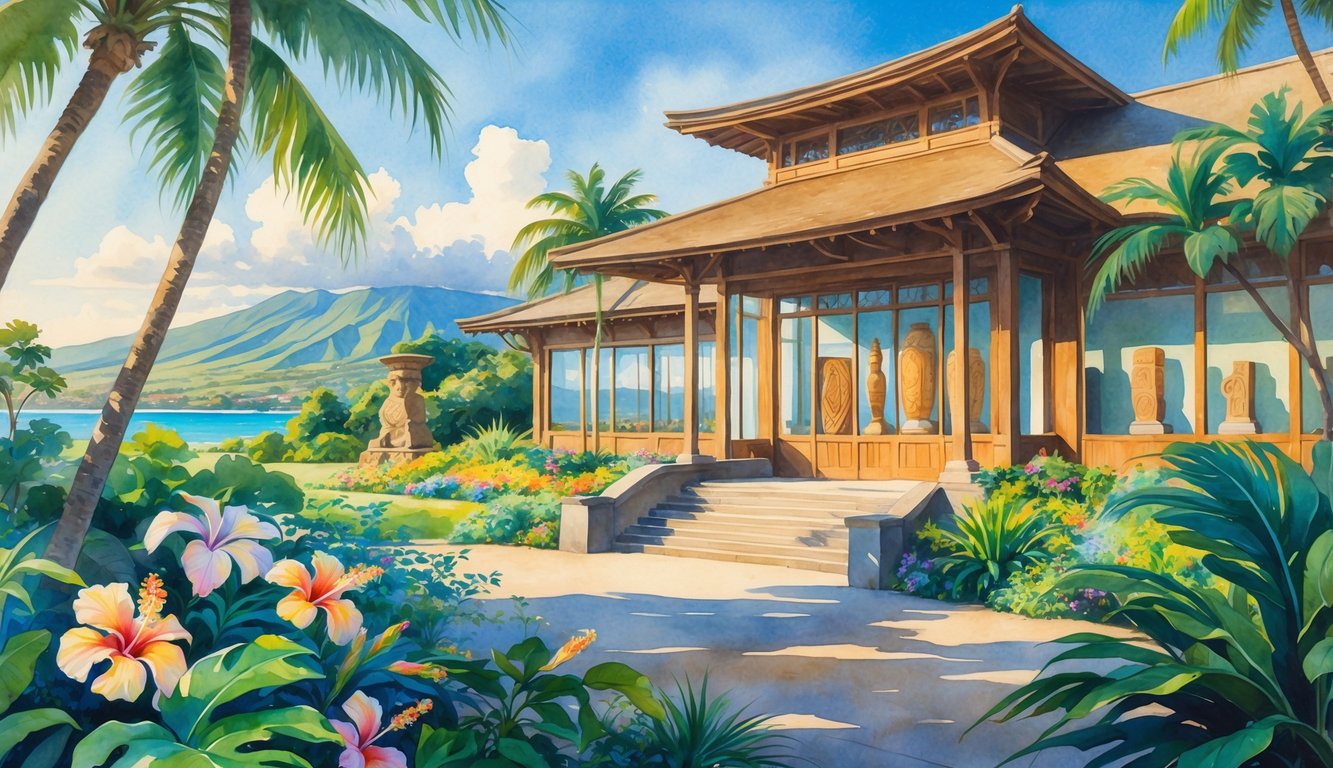
Maui has unique spots that showcase Hawaiian history and international collections. Some display local traditions, while others feature global influences that reached Hawaii’s shores.
Bailey House
The Bailey House Museum is a special place in Wailuku, Maui. It holds a mix of art and Hawaiian heritage in one spot.
The museum sits in an old missionary home from the 1800s and feels like a step back into island history.
Inside, you can see original paintings by Edward Bailey, who lived there and captured Maui’s landscapes. The museum also displays artifacts like native tools, quilts, and royal items.
Traditional Hawaiian woodwork and feather capes are shown alongside detailed models of outrigger canoes. The gardens outside are full of native plants.
I enjoy walking around and seeing how art blends with everyday objects from early Maui life. There’s a small gift shop featuring local artists’ works, so you can support the community.
More information about the Bailey House can be found at the Best Museums on Maui.
Shangri La Museum of Islamic Art
Although Shangri La Museum of Islamic Art is not on Maui, it deserves attention if you’re interested in how global art influenced Hawaii. Doris Duke, a wealthy collector, once lived here and filled the home with treasures from across the Islamic world.
When I enter Shangri La, I see a mix of tilework, textiles, carved wood, and metal pieces. The museum displays art from countries like Iran, Egypt, India, and Syria.
Rooms show off colorful ceramics, patterned carpets, and hand-carved screens. I notice how Duke admired global beauty and brought it to Hawaii.
The museum offers tours and special exhibits. It connects Hawaii to worldwide art traditions and highlights Islamic art’s beauty in an oceanfront setting.
By comparing this space to Maui’s museums, I get a broader view of artistic influence in the islands. You can learn more about this collection by visiting the best museums in Maui and Hawaii.
Exploring the Museums of Kauaʻi
Kauaʻi offers special places where I can learn about the island’s art, history, and culture. Some museums feature Hawaiian art while others focus on the island’s heritage.
Kauaʻi Museum
At the Kauaʻi Museum in Līhuʻe, I find a wide range of Hawaiian art and artifacts that show the history of Kauaʻi and Niʻihau. The museum features local fine art, including paintings, sculptures, and traditional crafts.
The exhibits tell the story of native Hawaiian culture and the era of Hawaiian royalty. Displays also cover everyday life from different periods in Kauaʻi’s past.
Friendly staff and knowledgeable docents share fascinating stories, making each visit unique. Sometimes, guided tours help me connect the art and history on display.
The museum includes plaques and photographs, giving a visual timeline of how the island’s art and culture have changed. You can learn more or plan a visit at the Kauaʻi Museum official website.
Cedar Street Galleries
Cedar Street Galleries is not on Kauaʻi but is well-known across Hawaiʻi for its focus on local Hawaiian artists and contemporary art. When I step inside, I see works in many media, such as paintings, glass art, and carvings that show Hawaiian themes and landscapes.
The gallery supports artists from all over the islands, offering a look at modern Hawaiian creativity. Visitors can view or purchase original artwork, so collectors can bring a piece of Hawaiʻi home.
Cedar Street Galleries hosts rotating shows and special exhibitions. I enjoy returning to see new talent and ideas on display.
Palaces and Historic Sites Featuring Hawaiian Art
Many important museums in Hawaii are actually historic palaces. These places display Hawaiian art and hold artifacts that belonged to Hawaiian royalty.
Visitors can view rare treasures, original furniture, and artwork linked to famous kings and queens. Each palace offers a unique look at Hawaii’s royal past.
ʻIolani Palace
When I visit ʻIolani Palace in downtown Honolulu, I step inside the only royal palace in the United States. King Kalākaua and Queen Liliʻuokalani had this National Historic Landmark built in 1882.
The building itself is impressive, but the true treasures are inside. Guided tours show original royal portraits, historic furniture, and objects collected by the royal family.
The Throne Room and Grand Hall feature intricate woodwork and elegant design. Exhibits help me understand the story of the Hawaiian Kingdom and its last monarchs.
You can read more about its history at ʻIolani Palace.
Queen Emma Summer Palace
Queen Emma Summer Palace, or Hānaiakamalama, shows how Queen Emma, King Kamehameha IV, and their son spent their summer days. The house contains art, personal belongings, and original furnishings from the royal family.
Displays include beautiful quilts, fine china, and portraits that give a sense of life during the 1800s. I enjoy seeing royal artifacts like feather cloaks and helmets, which are important in Hawaiian culture.
The palace sits among lush gardens, making it a relaxing place to learn about Hawaiian royalty. Staff members share stories that make each visit feel personal.
Hulihe‘e Palace
When I tour Hulihe‘e Palace in Kailua-Kona, I learn how Hawaiian royalty lived on the Big Island. This former vacation home for King Kamehameha I and later royal families now serves as a museum with historic artifacts and Hawaiian art.
Inside, I find koa wood furniture, royal gowns, and personal items that belonged to the kings and queens. The palace is known for its collection of kahili (feather standards), paintings, and imported china.
I am drawn to the historic photographs and antique musical instruments. Each room is carefully restored to reflect its royal past.
Museums Dedicated to Hawaiian History and Daily Life
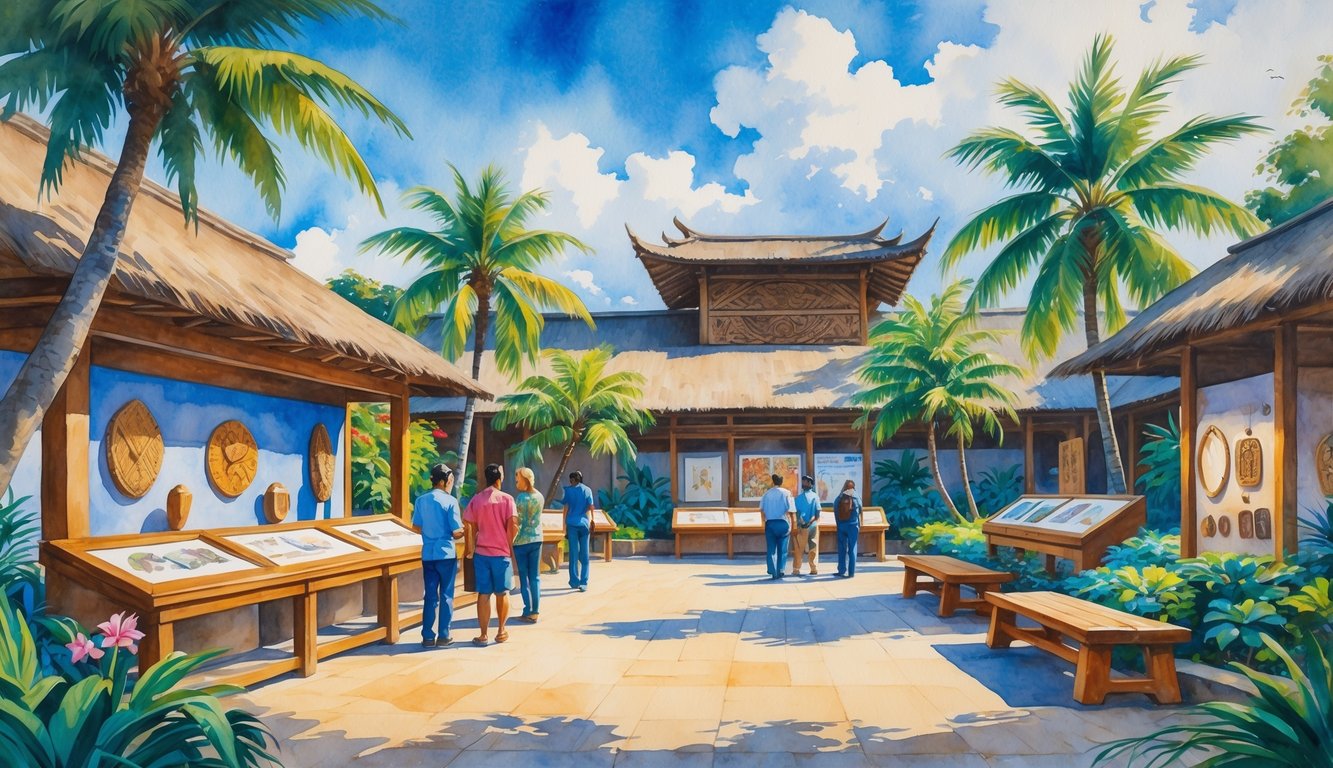
Exploring Hawaiian history through its museums helps me see how daily life shaped the islands. By visiting these places, I learn about the sugar industry, local farming, and the experiences of families who lived in Hawaii long ago.
Hawaii Plantation Village
At Hawaii Plantation Village, I walk through restored buildings and gardens that show what life was like for workers on a sugar plantation. The museum features homes and community structures used by immigrant workers from Japan, China, and the Philippines.
I see everyday objects, photos, and tools workers used. The displays help me understand the hard work they did and how they kept their cultures alive.
The village includes small details like beds, dishes, and toys from daily life. Guided tours share the history of each building and the people who lived there.
Special events during the year feature music, food, and crafts, making the experience personal.
Kona Coffee Living History Farm
The Kona Coffee Living History Farm shows me an early 20th-century coffee farm in action. Located in the Kona region, this site is a real farm, not just a display of equipment.
When I visit, guides in period clothing demonstrate tasks like picking coffee cherries, drying beans, and roasting coffee. I walk through the farmhouse and outbuildings, seeing original furniture, kitchenware, and laundry tools.
The farm tells the story of Japanese immigrant families who built the coffee industry on the Big Island. Staff demonstrate daily chores and explain how families lived and worked together to keep the farm running.
It’s a great way to learn about cultural history and local farming traditions.
H.N. Greenwell Store Museum
The H.N. Greenwell Store Museum brings me into a historic general store from the late 1800s in Kona. This store was a meeting place for ranchers, farmers, and plantation families.
Inside, shelves are filled with goods people actually bought, such as flour, sewing supplies, and lanterns. When I step inside, I feel like I’ve traveled back in time.
Museum staff talk about what early storekeepers did and share stories about the Greenwell family, who played a role in Kona’s growth. I see the mix of American, Hawaiian, and international products, showing how connected Kona was to the world.
The exhibits show how businesses like this supported daily life and helped the region grow.
Pearl Harbor and World War II Experience
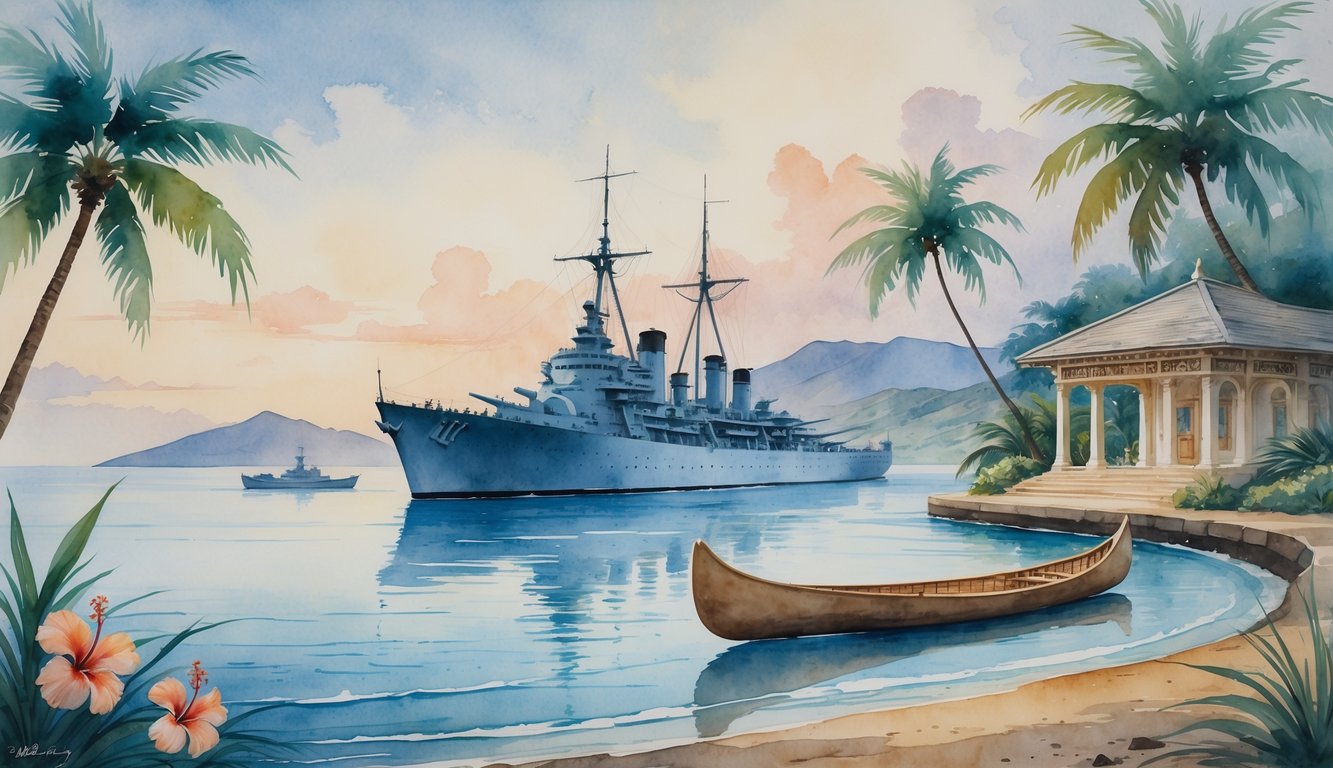
When I visit Pearl Harbor, I find a mix of history, personal stories, and artifacts from World War II. I walk where history happened, explore real vessels, and learn from engaging exhibits.
USS Arizona Memorial
The USS Arizona Memorial stands over the sunken battleship and honors the lives lost during the attack on Pearl Harbor. I take a short boat ride to the memorial and see the outline of the ship beneath the water.
At the memorial, I view the names of the fallen sailors engraved on the marble wall. The atmosphere is quiet and respectful.
Park rangers share stories, providing insight into the morning of December 7, 1941. Artifacts and exhibits explain what happened that day.
There are photos, recovered items, and interactive displays. Seeing these, I gain a deeper understanding of the impact on Hawaii and the nation.
Admission to the memorial is free, but it’s a good idea to get a reserved ticket early since it gets busy, as explained by the Pearl Harbor Visitor Center.
Pearl Harbor Aviation Museum
The Pearl Harbor Aviation Museum, formerly the Pacific Aviation Museum, sits on Ford Island. I walk through two large hangars filled with restored World War II aircraft.
The displays include engines, flight gear, and other artifacts. Interactive exhibits help me experience what it was like for pilots and crew from that era.
There are planes like the Japanese Zero, B-25 bombers, and helicopters from later years. Some aircraft have visible bullet holes and battle scars, helping me picture the action during the attacks.
The museum offers flight simulators where visitors can try piloting a WWII plane. The Pearl Harbor Aviation Museum tells the story of both American and Japanese airmen and how air power shaped the war in the Pacific.
USS Bowfin Submarine Museum
Next to the visitor center, I explore the USS Bowfin Submarine Museum. The Bowfin is a real WWII submarine that I can walk through.
Climbing down into the passageways, I see how little space sailors had on board. The museum explains the role of submarines in the war.
There are torpedo displays, crew photos, and detailed models. Some hands-on exhibits let me try the periscope or listen to stories from former crew.
A chart shows the Bowfin’s missions and the enemy ships it sank. There’s also a memorial outside that honors U.S. submarine sailors who were lost at sea.
Battleship Missouri Memorial
The Battleship Missouri Memorial sits on Ford Island, just across from where the Arizona rests underwater. The Missouri is famous for being the site where Japan officially surrendered, ending World War II.
I walk on the deck where the treaty was signed in 1945. Guided tours take me through gun turrets, officers’ quarters, and the control deck.
The ship’s size is impressive, with displays explaining its combat missions and postwar service. There are also exhibits about daily life for sailors during wartime.
I find it fascinating to stand on both the “beginning” (Arizona) and “end” (Missouri) points of America’s war in the Pacific. The Battleship Missouri Memorial is well-preserved, and there are many artifacts and photos throughout the ship to see.
Planning Your Museum Visit
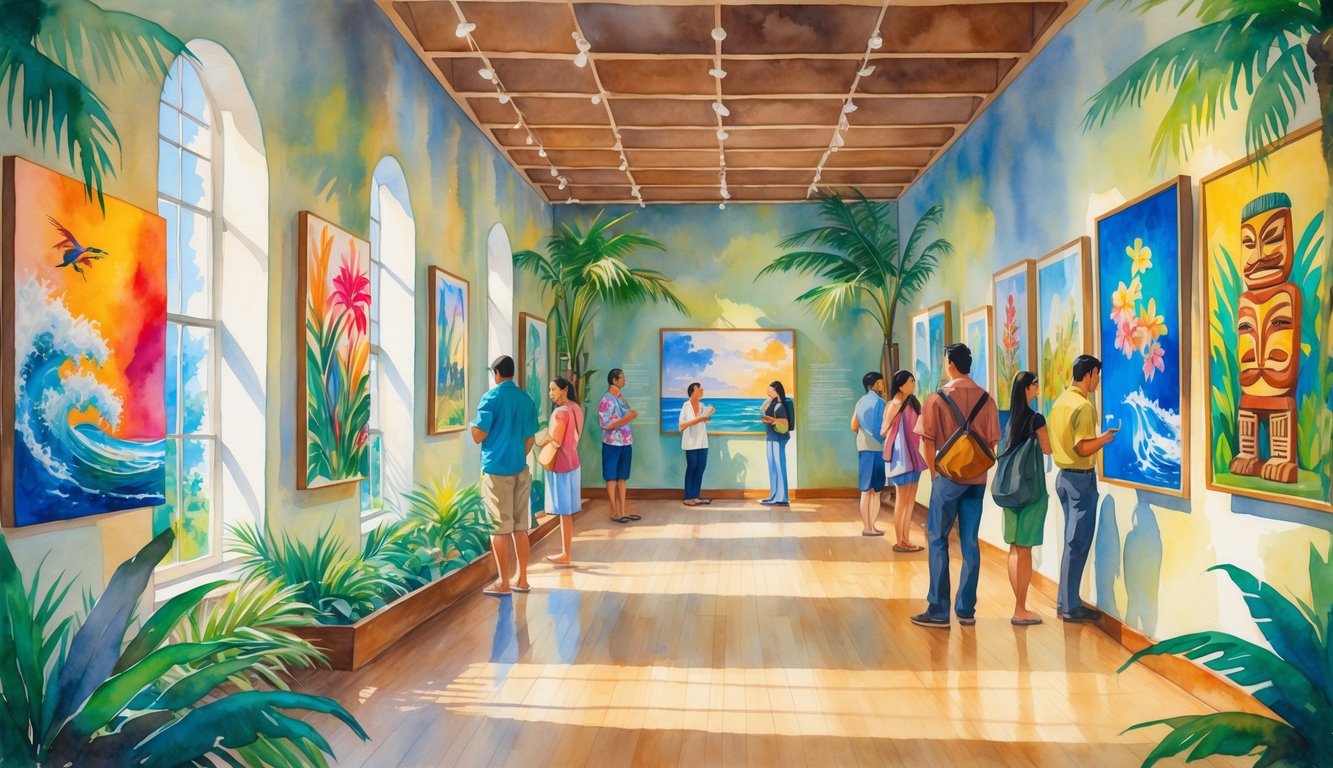
When I visit museums in Hawaii, I want to know about ticket prices and the best artwork and artifacts. I also check for special events or guided tours.
Knowing these details helps me enjoy everything the museums offer. Good planning makes my trip more enjoyable.
General Admission and Ticket Information
Each museum sets its own ticket prices and hours. For example, the Honolulu Museum of Art sells tickets online and at the door.
Adults usually pay about $20. Children and Hawaii residents often get discounts.
Some museums offer free admission on certain days. I always check the museum’s website or call for current prices and hours.
I save money by looking for museum passes or combo tickets if I plan to visit more than one spot. Popular museums like the Bishop Museum in Honolulu may require timed entry during busy seasons.
I recommend getting tickets in advance if possible. You can find more information about tickets, special deals, and opening hours on the official museum sites.
Most museums let me bring a backpack and camera. Some have rules about large bags, food, or flash photography.
Reading the museum’s visitor guide helps me avoid surprises.
Exhibit Highlights and Artwork
I look for both old and new Hawaiian art pieces. The Bishop Museum displays ancient Hawaiian artifacts like feather cloaks, wood carvings, and tools.
At the Honolulu Museum of Art, I find paintings, sculptures, and textiles from local artists. The museum also shows works from Asia and the Pacific.
Some museums focus on one artist or style. Others offer a wide mix.
Many museums change their displays throughout the year. Temporary exhibitions might include modern art, photographs, or student artwork.
I check the museum calendar so I don’t miss anything interesting. Many places make learning easy with plaques or digital screens that explain the objects.
If I’m interested in a certain topic, like Polynesian migration, I look for museums with strong history collections. For more about art collections, I check reviews and exhibit highlights at museum guides such as Hawaii Magazine.
Guided Tours and Events
Many museums in Hawaii offer guided tours, workshops, or special events. When I join a tour, I hear stories about the artists and see details I might miss on my own.
Some experts lead tours about Hawaiian artifacts or local art styles. Group tours usually come with admission, while private or themed tours might cost extra.
Special events often include live demonstrations, cultural performances, or art classes for kids and adults. At the Honolulu Museum of Art, I have joined drawing workshops and watched artists create new works in the gallery.
Some museums host family days, evening events, or lectures by guest curators or artists. I check the events calendar in advance to plan my visit.
For a list of current programs and tours, I look at museum events calendars or visit sites like Nani Hawaii’s guide for more details.
Appreciating Hawaiian Art Beyond Museums
Hawaiian art thrives in many places outside museum walls. I find that churches, markets, and neighborhoods all help tell the story of Hawaii’s artists.
Community Art Galleries
When I visit a community art gallery in Hawaii, I see artwork made by local artists who live on the islands. These galleries often sit in small towns or along busy tourist streets.
Some galleries, like those listed in Hawaii’s best art galleries, show paintings, jewelry, wood carvings, and photographs. These works capture ocean life, volcanoes, and native plants.
Many galleries offer workshops or art nights. I can meet artists, watch them work, and learn about the stories behind their pieces.
A few places let me try making my own simple items, like a small print or handmade card. The experience feels personal and genuine.
Here’s what I appreciate most about community art galleries:
- Direct interaction with the artists
- A focus on local culture and nature
- Changing exhibits so there’s always something new
- Opportunities to buy unique, handmade art as souvenirs
By visiting these galleries, I discover unique styles and stories that I don’t find in big museums.
Traditional and Contemporary Artists
In Hawaii, many artists keep traditions alive by using old techniques. I see kapa (barkcloth) makers, featherwork artists, and people who carve wood or stone by hand.
These creators often share their knowledge at festivals and community centers. They also teach at outdoor markets.
Contemporary artists use new materials or mix old methods with today’s trends. Some combine Hawaiian symbols with street art or digital design.
The Hawaii State Art Museum collects work from both traditional and modern artists. This variety lets everyone appreciate both the past and present in Hawaiian art.
Many artists share their lives and inspiration in short talks or art walks. They also post stories and updates on social media.
I like following their stories online to see new artwork or upcoming events. This connection makes the art feel more personal and helps me understand it better.




